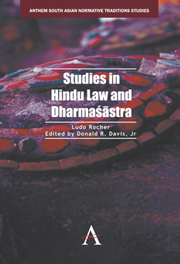Book contents
- Frontmatter
- Contents
- Foreword by Richard W. Lariviere
- Preface
- Abbreviations
- Note on the Edition
- Introduction
- PART ONE THE NATURE OF HINDU LAW
- PART TWO GENERAL TOPICS OF HINDU LAW
- Ancient Hindu Criminal Law
- Hindu Law of Succession: From the Śāstras to Modern Law
- Caste and Occupation in Classical India: The Normative Texts
- Megasthenes on Indian Lawbooks
- The “Ambassador” in Ancient India
- The Status of Minors according to Classical Hindu Law
- Quandoque bonus dormitat Jīmūtavūhanas?
- Notes on Mixed Castes in Classical India
- Inheritance and Srāddha: The Principle of “Spiritual Benefit”
- The Theory of Matrimonial Causes According to the Dharmaśāstra
- Jīmūtavūhana's Dāyabhāga and the Maxim Factum Valet
- The Divinity of Royal Power in Ancient India according to Dharmaśāstra
- A Few Considerations on Monocracy in Ancient India
- PART THREE HINDU LEGAL PROCEDURE
- PART FOUR TECHNICAL STUDIES OF HINDU LAW
- PART FIVE ANGLO-HINDU AND CUSTOMARY LAW
- Bibliography
- Index
Notes on Mixed Castes in Classical India
from PART TWO - GENERAL TOPICS OF HINDU LAW
Published online by Cambridge University Press: 05 February 2013
- Frontmatter
- Contents
- Foreword by Richard W. Lariviere
- Preface
- Abbreviations
- Note on the Edition
- Introduction
- PART ONE THE NATURE OF HINDU LAW
- PART TWO GENERAL TOPICS OF HINDU LAW
- Ancient Hindu Criminal Law
- Hindu Law of Succession: From the Śāstras to Modern Law
- Caste and Occupation in Classical India: The Normative Texts
- Megasthenes on Indian Lawbooks
- The “Ambassador” in Ancient India
- The Status of Minors according to Classical Hindu Law
- Quandoque bonus dormitat Jīmūtavūhanas?
- Notes on Mixed Castes in Classical India
- Inheritance and Srāddha: The Principle of “Spiritual Benefit”
- The Theory of Matrimonial Causes According to the Dharmaśāstra
- Jīmūtavūhana's Dāyabhāga and the Maxim Factum Valet
- The Divinity of Royal Power in Ancient India according to Dharmaśāstra
- A Few Considerations on Monocracy in Ancient India
- PART THREE HINDU LEGAL PROCEDURE
- PART FOUR TECHNICAL STUDIES OF HINDU LAW
- PART FIVE ANGLO-HINDU AND CUSTOMARY LAW
- Bibliography
- Index
Summary
§1. The so-called “mixed castes” in classical India have been studied in the past. The most comprehensive collection of data appears in P.V. Kane's History of Dharmaśāstra (1930–62: 2.69–104). In this paper I want to return to the original texts on which these data are based, schematize some of the materials, and try to draw certain conclusions. The texts are the Dharmasūtras, the early Dharmaśāstras, and Kauṭilya's Arthaśāstra, as follows:
– GDh, 4.16–21 (Stenzler's edition, Bühler's translation) = 4.14–17 (Ānandāśrama edition);
– BDh 1.16.6–8 + 1.17.3–8 (Hultzsch's edition, Bühler's translation) = 1.16.7–8 + 1.17.2–8 (Kashi edition);
– VaDh 18.1–6, 8–9;
– ViDh 16.2–6;
– MDh 10.6, 8–9, 11–12, 16–17;
– YDh 1.91–95;
– AŚ 3.7.20–30.
It should be noted that one Dharmasūtra, that of Āpastamba, does not discuss the matter of mixed castes.
§2. On the other hand, Gautama gives two sets. A first set is followed by a second one, introduced by: “Some say…” The interesting point is that not only the content but also the way of presentation in both sets are totally different; I shall return to this point later (§29).
§3. Baudhāyana also introduces mixed castes twice, one after the other. The situation is far more confused in this treatise, and considerable text-critical research will be required to solve the problem. The first passage follows immediately after the rules on the number of wives members of the four varṇas are allowed to have: from four to one.
- Type
- Chapter
- Information
- Studies in Hindu Law and Dharmasastra , pp. 255 - 266Publisher: Anthem PressPrint publication year: 2012



